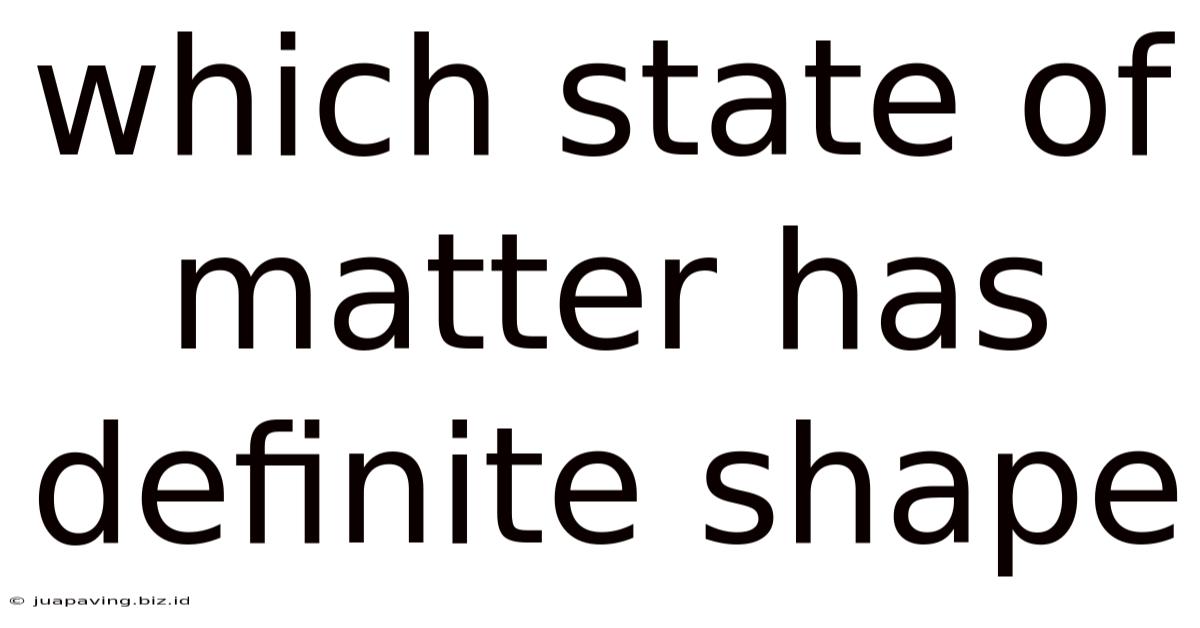Which State Of Matter Has Definite Shape
Juapaving
May 11, 2025 · 4 min read

Table of Contents
Which State of Matter Has a Definite Shape? Exploring Solids, Liquids, and Gases
The question of which state of matter possesses a definite shape is fundamental to understanding the physical properties of materials. While the answer might seem straightforward, a deeper exploration reveals nuances and exceptions that enrich our understanding of the molecular behavior underlying each state. This comprehensive guide will delve into the characteristics of solids, liquids, and gases, elucidating their respective shapes and the forces that govern them. We'll also touch upon plasma, the fourth state of matter, and its unique properties.
Understanding the States of Matter
Before we pinpoint which state boasts a definite shape, let's establish a clear understanding of the three primary states: solid, liquid, and gas. These states are differentiated primarily by the arrangement and movement of their constituent particles (atoms, molecules, or ions).
Solids: The Champions of Definite Shape
Solids are characterized by a definite shape and volume. Their particles are tightly packed together in a highly ordered arrangement, held in place by strong intermolecular forces. These forces restrict the particles' movement, preventing them from flowing freely. This fixed arrangement accounts for the solid's rigid structure and resistance to deformation.
Types of Solids: To further understand the rigidity of solids, it’s helpful to distinguish between crystalline and amorphous solids.
-
Crystalline Solids: These possess a highly ordered, repeating three-dimensional arrangement of particles. This ordered structure gives rise to their characteristic shapes, often seen as distinct facets or crystal faces. Examples include diamonds (carbon), quartz (silicon dioxide), and table salt (sodium chloride). Their definite shape is a direct consequence of this highly structured internal arrangement.
-
Amorphous Solids: In contrast to crystalline solids, amorphous solids lack a long-range ordered structure. Their particles are arranged randomly, although they are still relatively close together. While they maintain a definite shape at a given temperature and pressure, this shape is not as sharply defined as in crystalline solids. Examples include glass, rubber, and many plastics. They can be molded and shaped more easily than crystalline solids due to their less rigid structure.
Factors Affecting Solid Shape: While solids generally maintain a definite shape, external factors can influence their form. High temperatures can soften some solids, allowing them to deform. Similarly, application of significant force can alter the shape of a solid, although it will usually return to its original shape once the force is removed (elastic deformation). Beyond the elastic limit, permanent deformation occurs.
Liquids: A Story of Indefinite Shape
Unlike solids, liquids do not have a definite shape; they conform to the shape of their container. While their particles are close together, like those in solids, they are not rigidly held in place. The intermolecular forces in liquids are weaker than those in solids, allowing particles to move and slide past each other. This fluidity is the reason liquids can flow and fill the available space within a container.
Volume Remains Constant: Despite their indefinite shape, liquids do possess a definite volume. The particles are sufficiently close together that the volume remains relatively constant, regardless of container shape. Compression of a liquid requires significant pressure due to the proximity of its particles.
Gases: The Masters of Indefinite Shape and Volume
Gases stand in stark contrast to both solids and liquids. Gases possess neither a definite shape nor a definite volume. Their particles are widely dispersed and move freely and rapidly, with minimal intermolecular forces holding them together. They will expand to fill any container they occupy, adopting both the shape and volume of their surroundings. This behavior is a direct consequence of the high kinetic energy of gas particles.
Plasma: The Fourth State of Matter
Plasma is often considered the fourth state of matter. It's a superheated ionized gas, meaning its constituent atoms have been stripped of some or all of their electrons. This creates a mixture of ions and free electrons, giving plasma unique electrical and magnetic properties. Plasma, like gases, lacks a definite shape and volume. However, it behaves differently from gases due to the presence of charged particles. Its behavior is governed by electromagnetic forces rather than solely by intermolecular forces.
Conclusion: Solids Reign Supreme in Definite Shape
In summary, solids are the state of matter with a definite shape. While exceptions exist, such as amorphous solids which exhibit a less precisely defined shape, the overall rigidity and ordered structure of solids distinguish them from liquids and gases. Liquids conform to the shape of their container, and gases fill the entire available space. Plasma, while possessing properties distinct from gases, also lacks a definite shape. The understanding of these different states of matter is crucial in various fields, from material science and chemistry to physics and engineering. Exploring the molecular forces and arrangements that define each state provides a deeper appreciation for the rich diversity of the material world.
Latest Posts
Latest Posts
-
What Is A Comparison Sentence In Math
May 11, 2025
-
The Lcm Of 20 And 25
May 11, 2025
-
Whats The Difference Between A Rhombus And A Square
May 11, 2025
-
Which Laboratory Activity Involves A Chemical Change
May 11, 2025
-
Non Keratinized Stratified Squamous Epithelium Location
May 11, 2025
Related Post
Thank you for visiting our website which covers about Which State Of Matter Has Definite Shape . We hope the information provided has been useful to you. Feel free to contact us if you have any questions or need further assistance. See you next time and don't miss to bookmark.